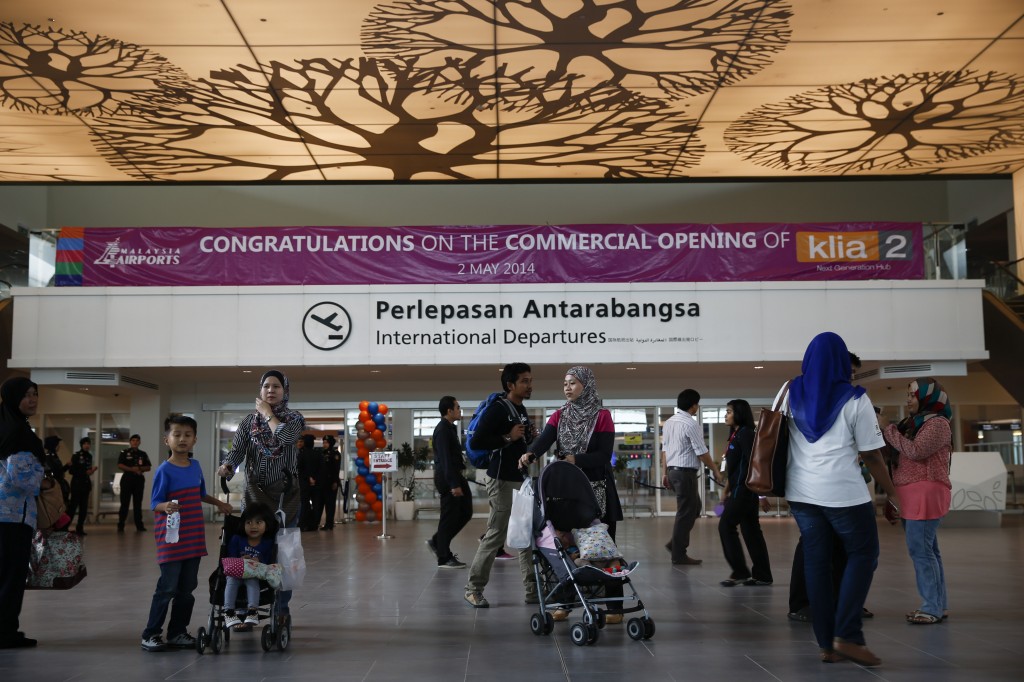New Malaysian budget airport opens

Passengers wait at the entrance of International departure hall on the opening day of new terminal KLIA2 in Sepang, Malaysia, Friday, May 2, 2014. Malaysia opened what it said was the world’s largest purpose-built terminal for low cost carriers in Kuala Lumpur. AP PHOTO/VINCENT THIAN
SEPANG—Malaysia on Friday officially opened a new airport built specifically for the fast-growing budget-travel sector, but with the country’s aviation industry under deep scrutiny over the loss of missing flight MH370.
The much-delayed new facility near the main Kuala Lumpur International Airport (KLIA) officially commenced operations at 12:05 am (1605 GMT) when a flight by Malaysia-based Malindo Air touched down.
Dubbed “KLIA2”, authorities say the facility is the world’s largest built specifically for budget airlines.
It is a modern, spacious change from an existing nearby low-cost terminal in use since 2006 — a cramped and bare-bones airport resembling a bus station and which is bursting at the seams due to the growth of budget travel spearheaded by Malaysia’s AirAsia.
By contrast, the high-ceiling KLIA2 is about four times bigger, features natural lighting, a sky bridge connecting to a satellite terminal and dozens of restaurant and shopping outlets.
Article continues after this advertisementAn automated baggage handling system replaces the older terminal’s manual operation.
Article continues after this advertisement“It is much more comfortable. The environment is bright and clean and it took me only about five minutes to walk out after the plane landed,” said Nur Shafarina, a construction company employee who flew in from the Malaysian state of Penang.
Airport officials said the terminal would handle 54 flights on Friday, involving about 700 passengers.
That will ramp up by May 9 when budget-travel leader AirAsia—by far KLIA2’s largest tenant—is expected to fully migrate from the old terminal.
Flights will rise to 450 per day involving about 70,000 passengers, said Azmi Murad, a senior manager with state-linked airport operator Malaysia Airports Holdings Berhad (MAHB).
24 million passengers expected in first year
Budget carriers using KLIA2 from Friday include Malindo Air, the Philippines’ Cebu Pacific Air, Singapore’s Tiger Airways, and Indonesia’s Lion Air, officials said.
Kuala Lumpur has been at the core of a regional budget-travel boom credited in large part to AirAsia.
The once-failing airline was rescued from the scrap heap in 2001 by outspoken Malaysian entrepreneur Tony Fernandes.
He quickly turned it into one of the aviation industry’s biggest success stories, its rapid regional expansion helping to broaden a market that has benefitted a host of Asian competitors.
The growth has overwhelmed the existing low-cost terminal, which is designed to handle 15 million passengers annually but saw 22 million squeeze through last year.
KLIA2’s capacity is 45 million passengers per year, and about 24 million are expected in the first 12 months.
The still-unexplained March 8 disappearance of Malaysia Airlines flight MH370, which took off from the main KLIA, has raised worldwide concern over Malaysian aviation and focused attention on problems at KLIA2.
The airport opens three years after originally planned due to repeated delays caused by concerns over safety and subpar construction, as its cost doubled to $1.2 billion.
AirAsia, which has complained loudly over the delays, said problems include depressions on runways and taxiways.
Authorities have acknowledged KLIA2 is on unstable ground that will require years of upkeep.
However, Malaysia said last week the International Civil Aviation Organization (ICAO) had inspected the facility and given its blessing.